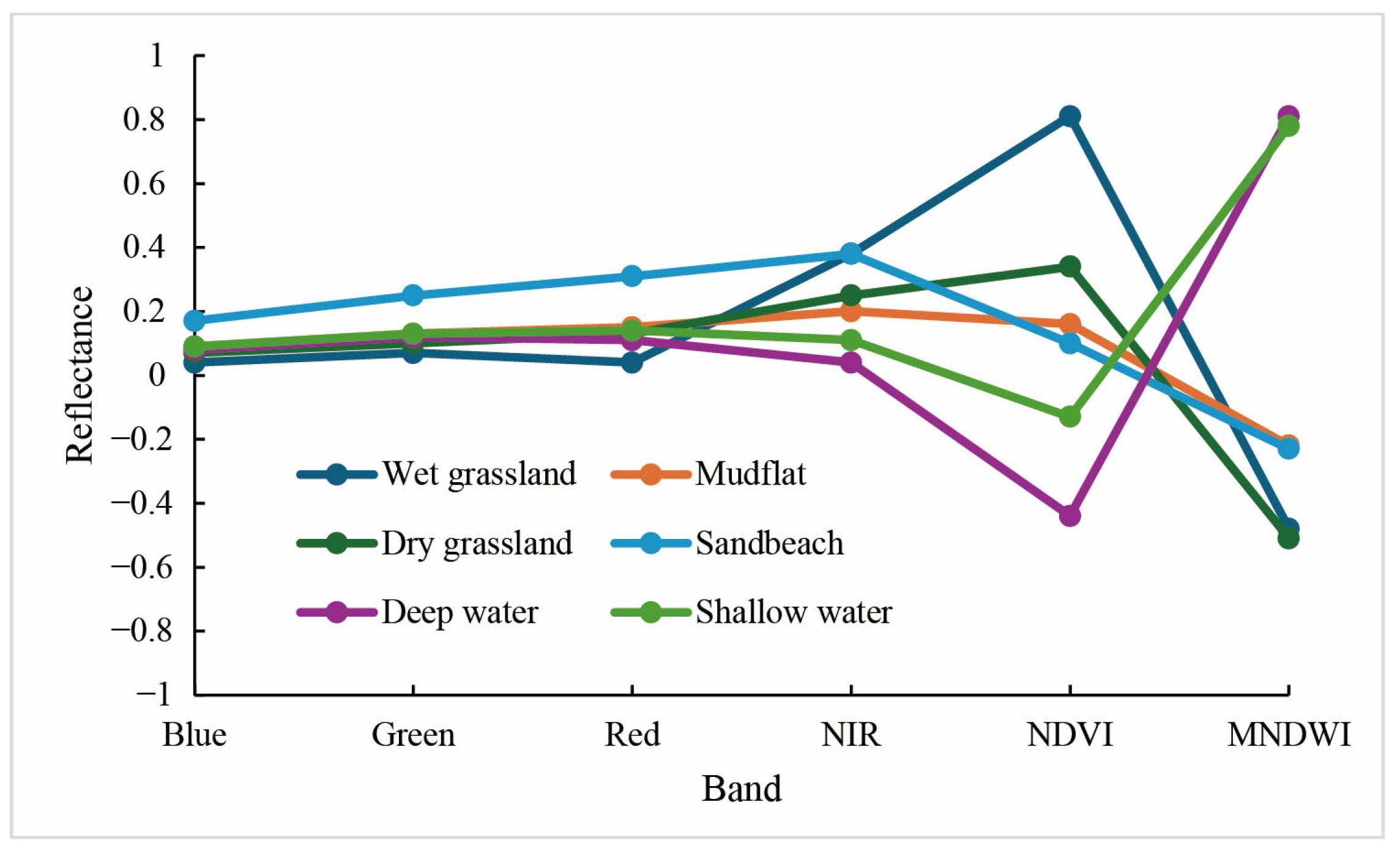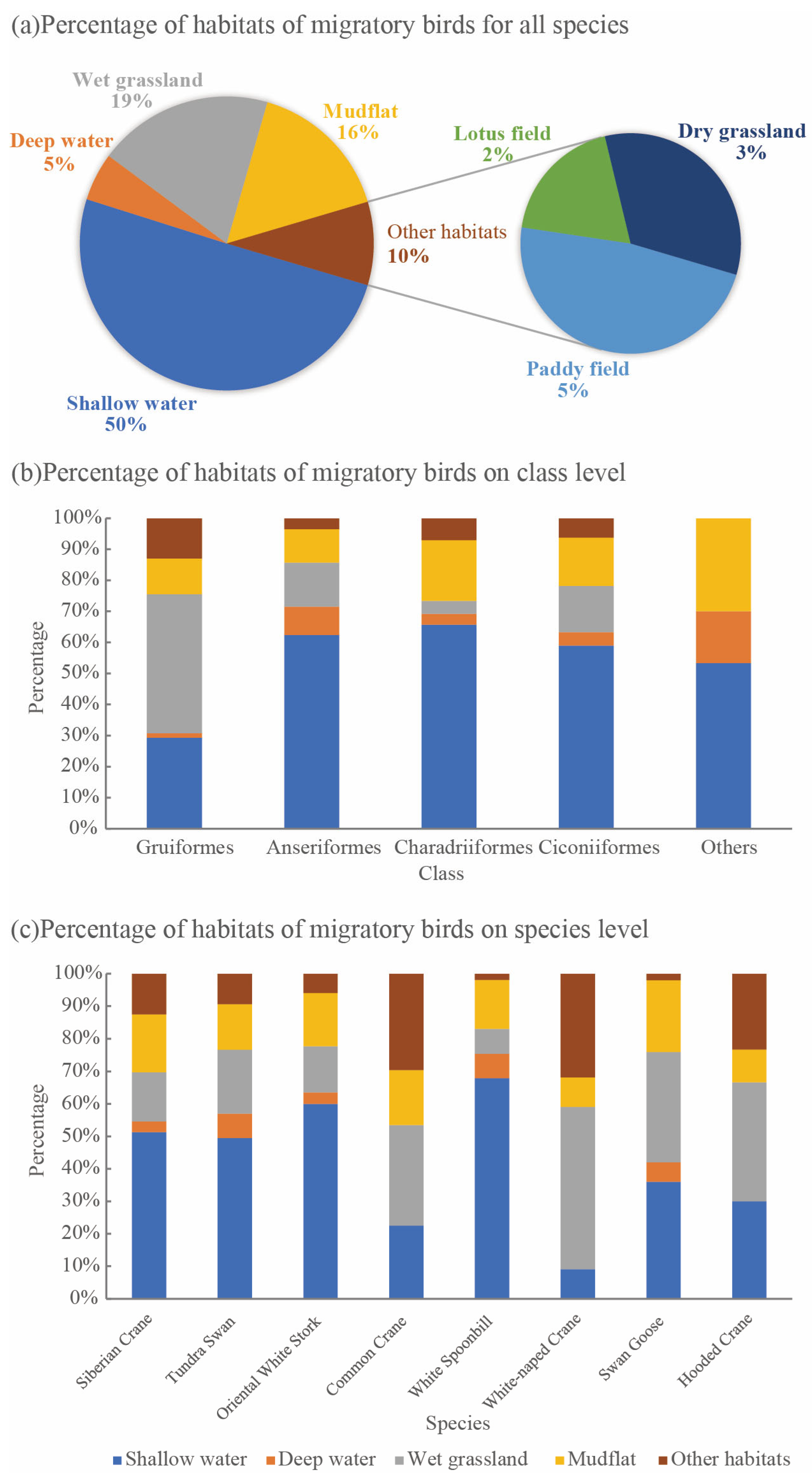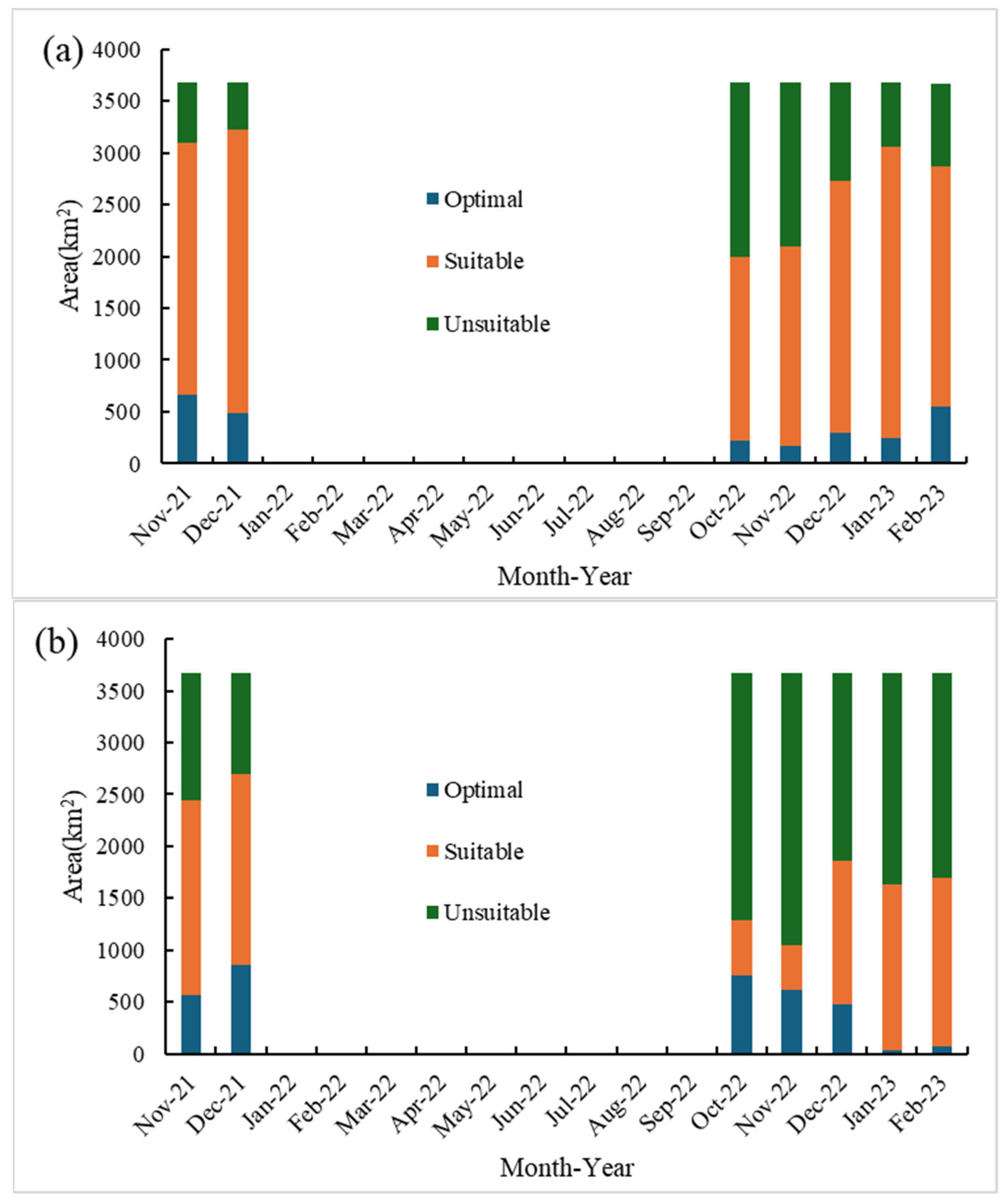4.1. The Importance of Crowdsourced Geographic Data for Habitat Assessment
With the proliferation of internet accessibility and the democratization of scientific knowledge, crowdsourced geographic information has emerged as a pivotal data stream in informing habitat conservation policies [
34,
35]. Unlike traditional expertise-driven data, crowdsourced geographic information is characterized by its diverse provenance, variable quality metrics and often imprecise geolocation specifics [
34]. Nevertheless, through meticulous data cleansing protocols and rigorous professional processing methodologies, crowdsourced geographic information can furnish an impartial and robust dataset for habitat evaluation endeavors.
The integration of multi-source geographic datasets serves as a potent instrument for aggregating wildlife observations, fostering a participatory ethos wherein citizens actively contribute to wildlife research and stewardship [
50]. A case in point lies in Kallimanis et al.’s [
51] investigation into the fidelity of data amassed by citizen scientists for assessing habitat conservation statuses; their findings underscore that while a preponderance of non-expert-generated data were accurate, they frequently suffered from incompleteness. This underscores the potential and challenges inherent in harnessing crowdsourced geographic information for ecological applications, advocating for refined methodologies that capitalize on its strengths while mitigating its limitations.
Our investigation underscores the pivotal role of crowdsourced geographic information in conducting habitat assessments for migratory birds, marking a significant methodological advancement. While extant research endeavors have predominantly relied upon expert-led experience and knowledge, coupled with remote-sensing technologies or hydrodynamic modeling, to decipher avian habitat characteristics within the Poyang Lake ecosystem [
15,
21,
52], there exists a conspicuous gap in leveraging the vast potential of public science. A sparse few studies have ventured into utilizing on-the-ground ecological surveys to scrutinize bird habitats in discrete wetland locales [
5]. Nonetheless, our study pioneers the integration of crowdsourced geographic information’s strengths, offering an unprecedented lens through which to examine migratory bird habitatology in the Poyang Lake region from a public scientist’s standpoint.
Through meticulous quantitative analysis, this research dissects the diverse habitat typologies crucial to migratory birds, shedding light on species-specific habitat predilections hitherto unexplored. Consistent with the results of previous studies [
53], shallow water plays the most crucial role in the habitat of wintering migratory birds, partly because of the relatively abundant food resources [
54]. This study quantifies the preference differences of various wintering migratory birds in Poyang Lake from the perspective of crowdsourced geographic information for the first time. As mentioned in
Section 3.1, wet grasslands are the favorite habitat of White-naped cranes. Compared with the Siberian crane, which prefers shallow water, the ecological niche of the White-naped crane avoids intense resource competition between the two [
55,
56]. Therefore, the habitat preferences of wintering migratory birds need to be evaluated more comprehensively, so as to provide a better theoretical reference for the protection of migratory birds.
4.2. The Influence of Water Level on Habitats of Migratory Birds
Numerous studies have corroborated the profound influence of water level fluctuations on the wetland ecosystem, with Wu et al. [
52] being a case in point, evidencing this crucial hydrological control mechanism. The cyclical dance between seasonal inundations and droughts orchestrates a rich tapestry of wetland habitats and bolsters ecosystem productivity, as exemplified by the floodplains surrounding Poyang Lake. This natural rhythm, however, can be disrupted by excessive water level variations, such as those induced by unprecedented flood peaks or severe drought conditions, which pose formidable challenges to the structural integrity and functional resilience of these ecosystems.
Empirical evidence underscores the heightened vulnerability of wetland vegetation under the dual stresses of post-flood droughts and extreme flooding events. Such disturbances not only compromise the vegetative fabric but also undermine the habitat functionality essential for sustaining migratory bird populations. This phenomenon is echoed in observations from two of the largest freshwater lakes in China, where Hong et al. [
10] and Wu et al. [
21] have documented similar detrimental impacts on avian habitats, highlighting the delicate balance within these ecosystems and the urgent need for effective water level management strategies to preserve their ecological services and biodiversity. Thus, understanding and mitigating the repercussions of extreme hydrological events are imperative for the conservation of wetland ecosystems and the myriad species they support.
The repercussions of extreme drought phenomena on wetland ecosystems can have far-reaching implications for migratory bird populations, manifesting through disruptions in food chains and the degradation of vital habitats. Empirical evidence suggests that the Poyang Lake region, under severe water scarcity conditions, such as those observed in 2022, experiences a notable decline in migratory bird numbers [
7,
52]. This study’s findings reveal that, compared to average hydrological years, the wintering period during extreme drought years witnesses an expansive distribution of unsuitable habitats for migratory birds across Poyang Lake, with the area deemed most conducive for these avian species contracting by approximately 60%.
Extreme drought conditions exert dual pressures on the ecosystem. Firstly, they induce stress on wetland plants and submerged vegetation, impeding their growth and thereby jeopardizing the food availability essential for herbivorous migratory birds [
10]. Secondly, these arid conditions precipitate the emergence of numerous desiccated shorelines within lakes, which in turn constricts the living spaces available for benthic organisms and fish populations [
4]. Consequently, this ecological crunch leads to a dramatic reduction in suitable habitat areas for migratory birds, exacerbating the challenges faced by these species in their already precarious migratory journeys. These findings underscore the critical need for effective water resource management and conservation strategies to mitigate the impacts of extreme droughts on wetland ecosystems and safeguard the biodiversity they sustain.
Extreme drought has led to the damage of the structure and function of the lake wetland ecosystem [
57,
58], thereby affecting the suitability of the wintering migratory bird habitat. An important finding of this study is that the impact of extreme drought on the suitability of migratory bird habitats is not the same, which depends on the preferences of migratory bird habitats. As shown in
Section 3.2 and
Section 3.3, the extreme drought in 2022 led to a sharp shrinkage in shallow water, but the area of mudflats and dry grasslands increased to a certain extent, thereby affecting the change in the suitable area for migratory bird habitats. For most migratory birds represented by the Siberian crane, the suitable habitat types are shallow water, grassland and mudflats. However, the most suitable habitat type for the White-naped crane is wet grassland, followed by mudflats and shallow water. Therefore, the adverse impact of the extreme drought in 2022 on the White-naped crane was more significant than that on the Siberian crane. The main reason among them is that extreme drought causes the wetland vegetation to wither under water stress [
59,
60], and it is difficult to recover in a short time.
It is pivotal to acknowledge the disproportionate significance of sub-lakes as refugia for migratory bird habitats amid extreme drought conditions. These sub-lakes, the integral components of Poyang Lake’s geomorphology, owe their existence to the dynamic interplay between fluctuating flood and drought cycles and the protracted imprint of local anthropogenic activities [
5,
6,
7]. During the flood season, these subsidiary bodies of water merge with the lake’s expanse, facilitating the migration and reproductive processes of fish populations. Conversely, in the aridity of the dry season, they sever superficial hydrological ties with Poyang Lake’s primary basin, thereby crystallizing into discrete wetland ecosystems. Empirical research underscores the critical role that these secluded aquatic environments play in harboring a diverse array of migratory bird species, effectively serving as oases amid the parched landscapes [
5]. This underscores the imperative for conservation strategies targeting these ephemeral wetlands, particularly in the face of escalating drought frequencies and intensities, to preserve the ecological integrity and biodiversity they uphold.
Nonetheless, the prolonged persistence of low water levels exerts detrimental effects on the ecological fabric of sub-lake wetlands, albeit the delineation of a threshold for these repercussions remains an avenue for further scientific inquiry. The global ubiquity of similar small water body ecosystems, such as those observed in the Tonle Sap floodplains of the Mekong River [
61] and Lake Curuai within the Amazonian basin [
62], underscores their ecological significance. Empirical evidence has illuminated the disproportionately high aquatic biodiversity fostered by floodplain sub-lakes in comparison to both riverine and lacustrine counterparts [
63], positioning them as biodiversity hotspots.
These diminutive aquatic enclaves, given their propensity to serve as refugia for organisms amid environmental upheavals, warrant heightened attention within the realms of wetland rehabilitation and sustainable management paradigms [
5]. Recognizing their pivotal role in preserving biodiversity and facilitating ecological resilience, it becomes imperative to integrate strategies that safeguard these ephemeral ecosystems against the backdrop of a rapidly changing climate. Due to the length of the time series and the data volume limitations of crowdsourcing geographic information, this paper has not yet established a quantitative model to reveal the influence of extreme drought on migratory bird habitats. The integration of multi-source remote-sensing data, such as the Sentinel satellite series and the Landsat satellite series, is expected to expand the research scale within the framework of this paper, thereby establishing remote-sensing or weather-driven models and providing a scientific basis for the prediction and protection of migratory bird habitats in the future. Moreover, future research endeavors should thus focus on unraveling the specific mechanisms through which sub-lakes confer refugia status, as well as identifying management practices that can augment their resilience in the face of hydrological unpredictability.
4.3. Limitations and Further Research
This study endeavors to illuminate the transformative impacts of extreme drought conditions on the habitat of migratory birds inhabiting the Poyang Lake wetland, employing an innovative fusion of crowdsourced geographic intelligence and remote-sensing imagery as its methodological cornerstone. The integration of crowdsourced geographical data stands as a distinctive departure from extant research endeavors centered on migratory avian habitats within this vital ecosystem, underscoring our contention that such citizen-generated information harbors immense untapped potential for refining habitat suitability assessments.
Empirical outcomes corroborate the efficacy of this hybrid approach in yielding insights into migratory bird habitat dynamics, thereby validating its utility. Nevertheless, we acknowledge the inherent limitations within our methodology; notably, the coarse granularity of geographic data sourced from crowds complicates precise cartographic representation [
35], thereby imposing constraints on deeper analytical explorations of avian habitat intricacies. Occurrence frequency is a key indicator for evaluating the suitability of migratory bird habitats using crowdsourced geographic information in this paper. Its important prerequisite is that the higher the occurrence frequency of a certain habitat of migratory birds in crowdsourced geographic information, the higher the suitability of this habitat. Its deficiency is the lack of verification of the number of species. Meanwhile, news media reports may tend to focus on well-known species [
34], which need to be further explored in future studies.
For the public, due to the limited observation range, birds can usually only be observed at the bird-watching platforms or partially open areas of tourist attractions in Poyang Lake. The survey of overwintering waterbirds in Poyang Lake is conducted regularly every winter by the Wildlife Protection Administration of Jiangxi Province [
64]. Some of the data from the migratory bird survey are released through the WeChat official account platform. These data constitute the main source of crowdsourced geographic data of migratory bird habitat used in this study. Previous literature has reported the quantities and changes of monitoring wintering migratory birds [
64]. Therefore, by combining the migratory bird information released by the Wildlife Protection Administration, the spatial representativeness of the dataset can be improved to a certain extent. However, it is undeniable that there are geographical biases in crowdsourced geographic information. Even specialized researchers cannot achieve migratory bird observations in all geographical locations. Therefore, it is necessary to further explore how the spatial representativeness of crowdsourced geographic information affects the research results in future research.
Future prospects of migratory bird habitat conservation and the sustainable management of wetland ecosystems necessitate innovative strategies. In light of this, we advocate for the design and implementation of public science initiatives revolving around migratory bird habitat preservation. Such endeavors not only promise to enrich research methodologies but also serve as catalysts for enhancing public engagement and stewardship toward avian conservation. A pivotal component of this strategy involves rigorous monitoring of ecological and hydrological processes within representative sub-lake systems, with a keen eye on identifying critical lake level thresholds that exert discernible influences on sub-lake wetland ecologies. This knowledge is instrumental in fortifying the ecological resilience of both individual sub-lakes and the broader Poyang Lake wetland complex, thereby contributing to the long-term sustainability of these precious ecosystems.































